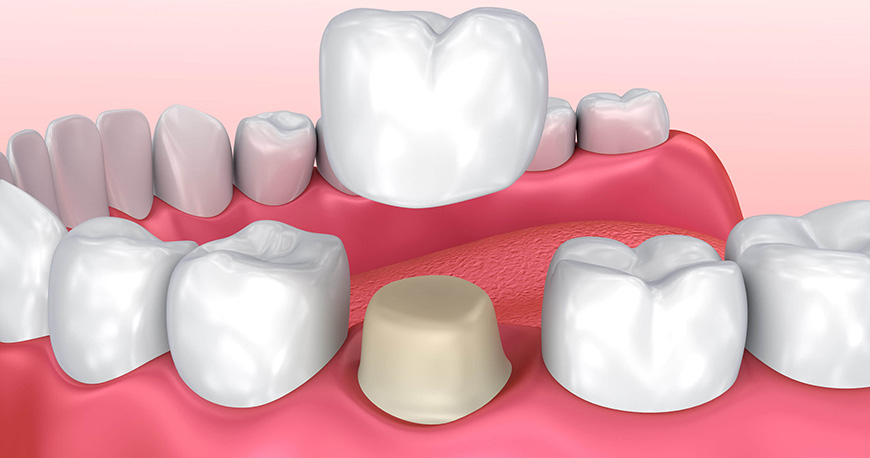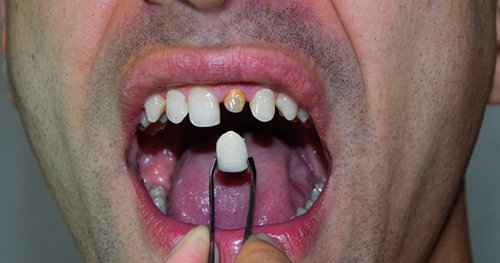
As a form of tooth restoration, Crowns are used to strengthen teeth. It is placed over the rest of a tooth that is prepared, strengthening it and giving it the appearance and shade of the natural tooth. It gives it a more natural appearance and can blend in with your other dental teeth.
When is a crown required? Crowns of dental origin are often used to fix:
Tooth decay Crowns help shield weak teeth, which are typically caused by severe decay.
Teeth that are cracked crowns are used to join the cracked teeth and restore their natural form, function, and appearance.
Teeth worn down Crowns can restore damaged or worn-down teeth, usually due to the onset of bruxism (teeth grind) or tooth erosion.
Big fillings Crowns are used to protect and strengthen teeth with massive fillings but have the smallest amount of tooth structure remaining.
Discolouration of the teeth is a condition that occurs when teeth are discoloured severely teeth-coloured crowns are commonly employed to conceal the discolouration. Other options include veneers and teeth whitening.
The type of crown material will differ depending on the area in which they are utilized. Zirconia and Emax crowns are the latest fashions in cosmetic dentistry, and their demand is growing each day. Zirconia is a tough and white-coloured material. Zirconia is a non-translucent substance which means that it does not allow light to penetrate, as opposed to natural teeth or porcelain. Due to their mechanical durability, they are utilized in molars as they are an area of load-bearing and less visually important region.
Emax is a form of all-ceramic crowns that provide outstanding aesthetic results. Although they offer the most natural appearance to dental fronts, Emax crowns may not be the most suitable option for areas that bear loads, such as the molars. Emax crowns are made of glass materials, making them more prone to breakage in high pressure, like on the molars.
Dental crowns typically can last anywhere from five to fifteen years. The crown's lifespan is determined by the degree of use and wears that the crown experiences, the extent to which you adhere to proper oral hygiene guidelines, and the habits you have for your mouth.

Crowns and veneers are two techniques for a dental restoration that enhance the appearance and function of your smile. The major distinction is that a veneer only covers just the surface of your tooth while crowns cover your entire tooth. It is a thin layer of porcelain or another material approximately one millimetre (mm) of thickness and is attached to the surface of your current tooth. A crown is approximately 2 millimetres thick and covers the entire tooth.
If your tooth is missing an extensive filling tooth canal that is damaged or broken, it is most likely that a crown is the best choice. When your tooth appears completely healthy with the restorative procedure being intended for aesthetic reasons, then an implant could be the ideal choice. Veneers can also be utilized for minor corrections of shape. Our Smile Makeover Marmaris Clinic is advised of the appropriate treatment needed for you by our expert dentist.

The individual cost varies based on how many teeth will be treated and the type of material selected. Zirconium crown weighs 175 pounds, and e.max crown weighs 235 pounds on Smile Makeover Marmaris Clinic.
After the crown has been installed, it is crucial to take care of it. Careful attention to your crown will extend its lifespan.
Be careful when you brush. If you're not brushing your teeth two times each day, you should begin. Think about using toothpaste suitable for sensitive teeth if your crown or teeth around them are tender to cold or hot.
Brushing every day twice can help keep your teeth in top form.
If your jaw is clenched or ground in late at night, your dentist might recommend a nightguard to guard the crown as well as your surrounding teeth.
-Chipped or Broken Teeth
-Worn out / Tooth Decay.
-Support an Existing Weak Tooth
-Covering discolored or misshaped teeth.
-To Cover dental implant(s).
-To Add length to an existing tooth.
-Mask tooth discoloration.
